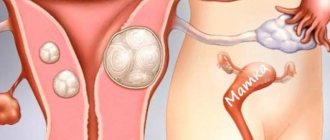Insidious fibroids
In the last 10 years, gynecologists for uterine fibroids, even when pregnancy occurs, have prescribed the drug “Utrozhestan” to patients. Women during the period of bearing a child are especially concerned about negative reviews about this medicine; patients outside of an interesting situation are also interested in the question of the advisability of such therapy. First you need to understand what uterine fibroids are, how they form, and whether you need to get rid of them.
The uterus consists of several layers that fit tightly together. The external (myometrium) is also commonly called muscular. When one of its cells develops defective during the process of division, but continues to divide, increasing the growth of similar (abnormal) “clones”, a benign tumor grows. It is called “fibroids”, and if it also consists of connective tissue, then you can find the name “fibroma” or “fibromyoma”.
Types of formations
Its possible harm also depends on where it grows:
- If the fibroid grows towards the inner layer of the uterus, it significantly complicates the process of bearing a child, since there will not be enough space for it.
- When it grows into the external environment, dysfunction of the bladder and intestines may occur. Sometimes a benign formation reaches large sizes (more than 15 cm), which causes significant discomfort to the excretory organs of the small pelvis.
- Intermuscular and intramuscular fibroids remain not the easiest to treat, as they are difficult to remove without harm to the reproductive organ itself.
Causes
The causes of such neoplasms are still not fully established, but they are often associated with a neurohormonal factor:
- With hormonal imbalances.
- With estrogen or progesterone deficiency.
- With stress.
- With damage to the uterus (due to abortion, childbirth).
Insufficient theoretical basis affects treatment methods. It is known that drug (hormonal, conservative) therapy is advisable to use when the tumor is small (up to 2 cm, up to the size of the uterus corresponding to the 12th week of pregnancy).
Complex treatment remains the most effective when it combines surgical intervention (removal of nodes) and hormonal intervention (to reduce the size of unwanted formations and their prevention).
In order not to bring the situation to emergency methods, it is necessary to visit an antenatal clinic with an examination at least once or twice a year.
Features and tips for taking Utrozhestan for uterine fibroids. Action of Utrozhestan for uterine fibroids
One capsule contains 200 mg of natural micronized progesterone hormone, as well as excipients. Accordingly, when taken regularly, this drug increases the level of progesterone in the blood and has a beneficial effect on the body.
The cycle becomes more regular. Pain during menstruation disappears. Blood loss during this period is reduced, etc. It is prescribed for menopause, fibrocystic mastopathy and other hormone-dependent neoplasms.
Cost and release form
The cost of the drug is from 423 rubles. It is produced by Vidal. Its analogues in terms of active substance and composition are Iprozhin and Prajisan. They cost a little cheaper - 350 and 250 rubles, respectively.
Utrozhestan is sold in only one dosage form - capsules. They consist of gelatin and have a soft shell. They contain progesterone itself, as well as excipients - sunflower oil, lecithin, titanium dioxide, glycerol.
The drug is sold in capsules of various dosages. The first option is a dosage of 100 mg, 14 pieces in a blister. The blister is placed in a cardboard box along with instructions. The second option is a dosage of 200 mg, 7 pieces in a blister.
general information
Ginestril is a synthetic antiprogestogen agent that can block progesterone receptors. The release form of the drug is tablets. They have a flat cylindrical shape and a light yellowish color. Both surfaces have chamfers.
The way Ginestril works is determined by its active ingredient - mifepristone. In addition to it, the composition includes a number of auxiliary components: microcrystalline cellulose, sodium carboxymethyl starch, calcium stearate and talc. They provide the tablet form and prevent mifepristone from breaking down during storage of the drug.
Available in three dosages used for various medical purposes:
- 10 mg mifepristone. Used as a means of post-coital contraception. Can be used within 72 hours after sexual intercourse.
- 50 mg of the active ingredient, for course treatment of uterine leiomyoma.
- Mifepristone 200 mg is approved for use only in medical institutions for medical abortion.
Ginestril is always available only with a prescription, which helps prevent the wrong prescription of the medication.
Indications
Strictly speaking, there is only one indication for taking this drug - progesterone deficiency conditions. Sometimes they develop with uterine fibroids. The drug is recommended for oral use in the following cases:
- Mastopathy of some nature;
- Luteal deficiency;
- Infertility due to the reasons written above;
- Premenstrual tension syndrome;
- The period before the onset of menopause;
- Menstrual irregularities.
The drug is actively used as HRT (hormone replacement therapy) during the period before and after menopause.
Vaginal administration of the drug is prescribed in the following cases:
- Threat of abortion due to lack of progesterone;
- Prevention of premature birth if there is a tendency to it or based on other factors suggesting a threat to pregnancy;
- Normalization of hormonal levels before in vitro fertilization;
- Premature menopause;
- Infertility;
- Hormone replacement therapy.
As can be seen from the description, there are two ways to administer capsules - orally and vaginally. In most cases, there is no significant difference in which way to take the medicine. However, in some cases, the doctor prescribes a specific method of administration. He also sets the required dosage based on the patient’s health.
Contraindications
For some diseases of the uterus and reproductive system, as well as in other cases, the medicine is contraindicated. Utrozhestan should not be used when:
- There is individual intolerance to its components;
- Porphyria;
- Malignant or unknown neoplasms in the reproductive system or mammary glands;
- There are venous diseases - thrombophlebitis, thrombosis, other disorders and hemorrhages, both in history and currently;
- Incomplete abortion;
- Uterine or other bleeding from the vagina, when its cause is not established;
- There are diseases of the cardiovascular system - arrhythmia, hypertension, etc.;
- Serious diseases related to the functioning of the liver;
- Kidney diseases;
- Tendency to depression;
- Tendency to migraines;
- Endocrine diseases of some types;
- Diabetes;
- Epilepsy, etc.
It is also undesirable to take it for bronchial asthma.
An interesting feature is that all these contraindications must be taken into account not only at the present time, but also their presence in the anamnesis.
For fibroids
Is it possible to prescribe Utrozhestan for fibroids? This issue remains quite controversial. As such, there are no contraindications for the use of this drug for fibroids. Thus, it is enough to conduct a study on tumor markers. After the doctor is sure that the tumor is not malignant, you can take this drug.
However, doctors have varying opinions about the effects of progesterone on fibroids. Some are of the opinion that drugs with this hormone can cause growth arrest. And sometimes the degradation of education.
Others, on the contrary, are of the opinion that increased progesterone levels cause the growth of the node. As an example, they cite the fact that in most cases it grows during pregnancy.
Possible complications
Side effects from the use of Utrozhestan are rare. Their appearance is associated in most cases with improper use of the drug, or exceeding the dosage prescribed by the doctor.
The following complications may occur:
- attacks of dizziness;
- increased drowsiness, fatigue;
- slight bleeding not associated with menstruation;
- dulling of attention and concentration.
If the dosage prescribed by the doctor is exceeded, allergic reactions may appear on the skin - rash, hives, redness on the skin. Rarely, nausea and vomiting are observed from taking Utrozhestan. If a woman experiences any complications, the drug should be stopped immediately.
Adverse symptoms do not require specific treatment. As a rule, the body’s condition normalizes on its own a few days after stopping taking Utrozhestan. When using the medicine for vaginal administration, there are no risks of side symptoms. Women who have been helped by Utrozhestan note that the treatment did not cause any complications for them.
Insidious fibroids
In the last 10 years, gynecologists for uterine fibroids, even when pregnancy occurs, have prescribed the drug “Utrozhestan” to patients.
Women during the period of bearing a child are especially concerned about negative reviews about this medicine; patients outside of an interesting situation are also interested in the question of the advisability of such therapy.
First you need to understand what uterine fibroids are, how they form, and whether you need to get rid of them.
The uterus consists of several layers that fit tightly together. The external (myometrium) is also commonly called muscular.
When one of its cells develops defective during the process of division, but continues to divide, increasing the growth of similar (abnormal) “clones”, a benign tumor grows.
It is called “fibroids”, and if it also consists of connective tissue, then you can find the name “fibroma” or “fibromyoma”.
Types of formations
Its possible harm also depends on where it grows:
- If the fibroid grows towards the inner layer of the uterus, it significantly complicates the process of bearing a child, since there will not be enough space for it.
- When it grows into the external environment, dysfunction of the bladder and intestines may occur. Sometimes a benign formation reaches large sizes (more than 15 cm), which causes significant discomfort to the excretory organs of the small pelvis.
- Intermuscular and intramuscular fibroids remain not the easiest to treat, as they are difficult to remove without harm to the reproductive organ itself.
Causes
The causes of such neoplasms are still not fully established, but they are often associated with a neurohormonal factor:
- With hormonal imbalances.
- With estrogen or progesterone deficiency.
- With stress.
- With damage to the uterus (due to abortion, childbirth).
Insufficient theoretical basis affects treatment methods. It is known that drug (hormonal, conservative) therapy is advisable to use when the tumor is small (up to 2 cm, up to the size of the uterus corresponding to the 12th week of pregnancy).
Complex treatment remains the most effective when it combines surgical intervention (removal of nodes) and hormonal intervention (to reduce the size of unwanted formations and their prevention).
In order not to bring the situation to emergency methods, it is necessary to visit an antenatal clinic with an examination at least once or twice a year.
Instructions for use of Ginestril (Method and dosage)
The drug Ginestril is indicated for:
- therapy for uterine leiomyoma (size up to 3 months of pregnancy);
- induction (stimulation) of labor during full-term pregnancy;
- termination of pregnancy (uterine) for up to 42 days of amenorrhea;
- emergency contraception (postcoital), if the contraceptive used is unreliable or in the period after completion of unprotected sexual intercourse.
For leiomyoma
- ovarian tumors;
- submucosal placement of myomatous nodes;
- endometrial hyperplasia;
- the size of the leiomyoma is more than acceptable (size up to 3 months of pregnancy).
- preeclampsia;
- severe gestosis;
- eclampsia;
- post-term or premature pregnancy;
- abnormal presentation of the fetus;
- disproportion between the sizes of the mother's pelvis and the fetal head;
- undiagnosed bloody discharge from the genital tract during pregnancy.
For uterine leiomyoma
Ginestril is usually prescribed in a single daily dose of 50 mg. The drug is taken orally for 3 months.
The use of Ginestril in dosages of up to 2 grams did not cause negative reactions.
In case of overdose, adrenal insufficiency may develop, which requires symptomatic treatment.
Source: https://BikiniMal.ru/matka/mifepriston-pri-miome.html
Hormones: radically opposing opinions
The most common reason for the appearance of a disease such as uterine fibroids is hormonal deficiency. But here opinions differ radically. Many gynecologists are inclined to believe that benign neoplasms are provoked by increased estrogen, so they prescribe synthetic analogues of progesterone (Dufostan, Utrozhestan).
A smaller group of scientists is inclined to suggest that tumors, on the contrary, grow due to increased levels of progesterone. Evidence is provided by observing pregnant women whose progesterone is always elevated (when compared with a non-pregnant patient).
In tablet form
“Utrozhestan” has the following properties and features, for which it is prescribed to representatives of the fair sex in cases of such deviations and pathologies associated specifically with progesterone (its insufficiency). Internal use:
- PMS (with pronounced symptoms).
- Pain during menstruation.
- Benign neoplasms in the mammary glands.
- The beginning of the decline of reproductive function (premenopause).
- For replacement therapy, but strictly in combination with estrogen.
Is it possible to take Utrozhestan for fibroids? Are Utrozhestan and Duphaston possible for fibroids?
One capsule contains 200 mg of natural micronized progesterone hormone, as well as excipients. Accordingly, when taken regularly, this drug increases the level of progesterone in the blood and has a beneficial effect on the body.
The cycle becomes more regular. Pain during menstruation disappears. Blood loss during this period is reduced, etc. It is prescribed for menopause, fibrocystic mastopathy and other hormone-dependent neoplasms.
Utrozhestan for uterine fibroids: benefits
Utrozhestan is prescribed for uterine fibroids quite often. There are especially many hormonal drugs on the pharmaceutical market that are designed to have a therapeutic effect on diseases. There is debate about the effect of hormones on tumors.
Hormones: radically opposing opinions
The most common reason for the appearance of a disease such as uterine fibroids is hormonal deficiency. But here opinions differ radically. Many gynecologists are inclined to believe that benign neoplasms are provoked by increased estrogen, so they prescribe synthetic analogues of progesterone (Dufostan, Utrozhestan).
A smaller group of scientists is inclined to suggest that tumors, on the contrary, grow due to increased levels of progesterone. Evidence is provided by observing pregnant women whose progesterone is always elevated (when compared with a non-pregnant patient).
But there may be another reason for the growth of fibroids - the entire reproductive organ is growing and, naturally, the tumor is growing too.
In tablet form
“Utrozhestan” has the following properties and features, for which it is prescribed to the fair sex in cases of such deviations and pathologies associated specifically with progesterone (its deficiency). Internal use:
- PMS (with pronounced symptoms).
- Pain during menstruation.
- Benign neoplasms in the mammary glands.
- The beginning of the decline of reproductive function (premenopause).
- For replacement therapy, but strictly in combination with estrogen.
Vaginal use
For vaginal use (as indicated in the instructions), the drug is used if:
- There are no ovaries and hormone replacement therapy (progesterone) is required.
- To maintain normal lutein (in case of disrupted menstrual cycles, in preparation for IVF, infertility for this reason).
- If pregnancy requires it (threat of miscarriage due to lack of progesterone).
- Prevention of fibroids.
- Treatment of endometriosis.
- Menopause and postmenopause (subject to parallel use of estrogen).
There are cases when gynecologists prescribe this drug vaginally to a woman in an interesting situation (it has the advantages of bypassing the gastrointestinal tract and does not affect the functioning of the liver, kidneys, or intestines) and does not cause drowsiness or depression. When used in this way, the drug is absorbed exclusively in the walls of the uterus.
“Utrozhestan” is categorically undesirable in the 2nd and 3rd trimester, when the level of progesterone in the body is already in sufficient quantity.
Elevated levels can lead to fluid retention, changes in kidney function, and problems with the placenta.
An important indicator remains the individuality of each treatment case. A deficiency of an important hormone, the level of which is measured during blood tests, may be an indication for the prescription of progesterone-containing drugs.
And something needs to be done
Despite sometimes even opposing reviews from doctors and patients about the action of such a remedy as Utrozhestan, its clear advantages remain, especially for uterine fibroids.
Benefits of Utrozhestan
The main advantages of the drug include:
- The product is effective in combination with estrogen-containing medications, when the natural reproductive function has already stopped and hormones are not produced in the required quantities. These are menopause and postmenopause.
- The medicine can indeed reduce a small tumor when its active growth cannot be allowed (including the period before surgical removal of the tumor).
- As a preventive technique (but strictly as prescribed by a doctor, spontaneous use of hormonal drugs risks leading to serious disorders of female sexual function).
- When there is a pregnancy up to 12 weeks (first trimester).
Unfortunately, patients may have different reactions to the popular medication.
In some, fibroma actually decreases, in others it progresses.
This may be due to incorrect diagnosis of the cause of the disease or a change in dosage. There are examples when a sharp increase or decrease in medication provoked additional growth of nodules.
And something needs to be done
Despite sometimes even opposing reviews from doctors and patients about the action of such a remedy as Utrozhestan, its clear advantages remain, especially for uterine fibroids.
Benefits of Utrozhestan
The main advantages of the drug include:
- The product is effective in combination with estrogen-containing medications, when the natural reproductive function has already stopped and hormones are not produced in the required quantities. These are menopause and postmenopause.
- The medicine can indeed reduce a small tumor when its active growth cannot be allowed (including the period before surgical removal of the tumor).
- As a preventive technique (but strictly as prescribed by a doctor, spontaneous use of hormonal drugs risks leading to serious disorders of female sexual function).
- When there is a pregnancy up to 12 weeks (first trimester).
Unfortunately, patients may have different reactions to the popular medication.
This may be due to incorrect diagnosis of the cause of the disease or a change in dosage. There are examples when a sharp increase or decrease in medication provoked additional growth of nodules.
Important Tips
Since there is no single correct opinion for all women, a certain algorithm should be followed for the most optimal therapy with Utrozhestan and other hormonal agents:
- Pregnancy should be planned; an examination by a gynecologist should not be carried out in a hurry. Complaints and questions should not be shy to voice. The visit should be taken seriously.
- If fibroids are diagnosed, it is necessary to begin treatment immediately. By postponing when the tumor grows to a larger size, the patient herself becomes the culprit of surgical treatment, since large nodes cannot be cured with medication.
- During an interesting period, when an unpleasant disease has been identified and an ambiguous treatment option has been prescribed (medical errors do occur), it is necessary to visit one or two more medical centers. If the majority of doctors confirm the previously proposed treatment method, then it is necessary to listen to the advice of specialists.
- If pregnancy promotes tumor growth and the prescribed drug should be taken, it is important to undergo an ultrasound to monitor the dynamics of the development of nodes.
What suppositories are used for uterine fibroids?
For uterine fibroids, the basis of the medication course is made up of different drugs; their use allows you to achieve positive results as quickly as possible. The effectiveness of such products is complemented by formulations in the form of suppositories. The suppositories have a gentle effect on the uterus and eliminate inflammation. Sometimes the purpose of use is to eliminate pain.
Most often, for uterine fibroids, gynecologists recommend using the following remedies:
- Sea buckthorn candles. They help fight various lesions of the cervix, because suppositories strengthen the immune system and accelerate recovery from inflammatory processes. They contain antioxidants and vitamins. The product is used 2 times a day, the duration of the course of therapy is 1 month.
- Suppositories with celandine. The process of formation of pseudotumors is stopped. Produced by Nizhpharm. They are administered rectally and vaginally, the frequency of use is 2 times a day for 10 days.
- Candles with natural propolis. Used to treat various gynecological pathologies. May be prescribed for the treatment of infertility. The drug is administered rectally 2 times a day, duration of use is 10 days.
- Candles with calendula. They belong to the group of anti-inflammatory drugs that can relieve pain. The product is used twice a day for a month. It is recommended to use it with extreme caution in women experiencing hypersensitivity reactions.
- Extra. The drug contains medicinal plants that can inhibit and prevent the process of development and division of pathological cells. The composition has an anti-inflammatory effect and is administered intravaginally or into the rectum. Duration of use – 10 days.
- Gero. Strengthens the body, eliminates inflammatory processes occurring in the organs of the reproductive system. Active components increase blood flow in the pelvic organs. The product is applied 3 times a day for 1 month, followed by a break of 2 weeks, then the treatment is repeated until the desired result is achieved.
- Phythoraxin. Ensures the destruction of abnormal cells and increases the body's protective properties. The drug should be used 2 times a day for 4 weeks. The drug is administered rectally or vaginally. To achieve the desired effect, the course is repeated several times.
- Genferon. The product is intended for the prevention and treatment of infectious and inflammatory processes. The product has a pronounced antibacterial effect. The drug is used vaginally 2 times a day for 10 days. The product can improve immunity.
- Ichthyol candles. The drug is intended for the prevention and treatment of infectious diseases of the pelvic organs. The product is used rectally, 3 times a day for 3-4 weeks. Through the use of the drug, it is possible to obtain a sustainable result in the treatment of uterine fibroids.
- Longidaza. Suppositories with enzymatic, anti-inflammatory and immunomodulatory effects. The drug ensures tumor resorption and regression of pathology. It has a gentle effect on nodular tissues and inhibits the process of their formation. The composition is recommended to be used 2 times a day for 2 weeks. As prescribed by a doctor, the period of use may be extended.
For reference! Uterine fibroids are a benign neoplasm of the female reproductive system that can be treated with medication.
Hormonal suppositories
These drugs are based on synthetic progesterone. It is recommended to use such a substance with extreme caution, since it can bring not only benefits to the body, but also harm. Drugs in this group include Utrozhestan and Endometrin.
Doctors are gradually moving away from the practice of using such compounds for fibroids, because under their influence the growth of the node may increase. The likelihood of tumor regression due to such therapy is minimized. Local gestagens are recommended for the treatment of endometriosis.
Chinese candles
Reviews from patients who have used Chinese tampons for uterine fibroids are quite varied. Many women confirm their effectiveness and claim that the power of medicinal plants is enough to resolve the tumor. The opinion of gynecologists on this matter cannot be called unambiguous. Doctors rarely recommend that patients use such formulations, since they are not medications.
It is impossible to say for sure whether the tumor will completely resolve from the use of vaginal and rectal suppositories. Only a doctor can select a good, and, most importantly, necessary drug after an examination and obtaining ultrasound data. Despite the fact that the active components of the drugs are not absorbed into the systemic bloodstream and generally do not have a negative effect on the body, they should not be used without a doctor’s prescription. In some cases, drugs can cause a sharp growth of the tumor due to increased blood flow in the organs of the reproductive system or due to increased hormonal activity.
This article is posted for educational purposes only and does not constitute scientific material or professional medical advice. Always trust your doctor first!
Operating principle
One capsule contains 200 mg of natural micronized progesterone hormone, as well as excipients. Accordingly, when taken regularly, this drug increases the level of progesterone in the blood and has a beneficial effect on the body.
The cycle becomes more regular. Pain during menstruation disappears. Blood loss during this period is reduced, etc. It is prescribed for menopause, fibrocystic mastopathy and other hormone-dependent neoplasms.
Cost and release form
The cost of the drug is from 423 rubles. It is produced by Vidal. Its analogues in terms of active substance and composition are Iprozhin and Prajisan. They cost a little cheaper - 350 and 250 rubles, respectively.
Utrozhestan is sold in only one dosage form - capsules. They consist of gelatin and have a soft shell. They contain progesterone itself, as well as excipients - sunflower oil, lecithin, titanium dioxide, glycerol.
The drug is sold in capsules of various dosages. The first option is a dosage of 100 mg, 14 pieces in a blister. The blister is placed in a cardboard box along with instructions. The second option is a dosage of 200 mg, 7 pieces in a blister.
Indications
Strictly speaking, there is only one indication for taking this drug - progesterone deficiency conditions. Sometimes they develop with uterine fibroids. The drug is recommended for oral use in the following cases:
- Mastopathy of some nature;
- Luteal deficiency;
- Infertility due to the reasons written above;
- Premenstrual tension syndrome;
- The period before the onset of menopause;
- Menstrual irregularities.
The drug is actively used as HRT (hormone replacement therapy) during the period before and after menopause.
Vaginal administration of the drug is prescribed in the following cases:
- Threat of abortion due to lack of progesterone;
- Prevention of premature birth if there is a tendency to it or based on other factors suggesting a threat to pregnancy;
- Normalization of hormonal levels before in vitro fertilization;
- Premature menopause;
- Infertility;
- Hormone replacement therapy.
As can be seen from the description, there are two ways to administer capsules - orally and vaginally. In most cases, there is no significant difference in which way to take the medicine. However, in some cases, the doctor prescribes a specific method of administration. He also sets the required dosage based on the patient’s health.
Utrozhestan for fibroids: instructions for use, indications and contraindications
Uterine fibroids are precisely this gynecological pathology that is diagnosed in approximately 45-50% of women of reproductive age. This pathology is a hormone-dependent benign neoplasm that affects the uterine myometrium. Growing in the cavity of the muscular layer of the uterus, fibroids are able to increase in size.
Modern medicine knows of cases where the weight of myomatous nodes reached several kilograms. The development of uterine fibroids is accompanied by severe uterine bleeding, anemia, infertility, and twisting of the leg of a benign neoplasm. In the most severe cases, the tumor can become malignant.
Today, not a single gynecologist can say with accuracy about the reasons for the development of a benign tumor in the uterine myometrium.
But the hormone-dependent type of fibroids clearly indicates that the main factor provoking the development of gynecological disease is a hormonal imbalance in the female body. This imbalance is characterized by disturbances in the normal production of female sex hormones - estrogen and progesterone.
That is why in the process of treating uterine fibroids, hormonal medications are mandatory, aimed at normalizing hormonal levels in the body.
One of the drugs that is most often used in hormone replacement therapy for uterine fibroids is Utrozhestan. What features of taking Utrozhestan should be remembered for the most effective treatment of uterine fibroids?
Utrozhestan - features of the drug
Utrozhestan is a drug from the group of gestagens. The main active substance that forms the basis of the drug is progesterone, also known as the ovarian corpus luteum hormone.
The main effect of Utrozhestan is the formation of a full-fledged endometrium in the female reproductive organ, reducing the excitatory and contractile activity of the uterine walls and tubes.
Taking Utrozhestan is recommended for fibroids that develop during pregnancy, since this drug is directly involved in preparing the uterus for the attachment of a fertilized egg, and also ensures the full development of the embryo.
Utrozhestan is available in the form of soft enteric-coated capsules.
The main active substance present in each capsule is natural micronized progesterone, the dosage of which is 100 or 200 mg.
The medicine must be taken orally or used for vaginal administration. At the same time, the maximum level of progesterone in the blood is achieved 2.5-3.5 hours after taking the Utrozhestan capsule.
Indications for taking Utrozhestan
Utrozhestan is recommended to be taken in the following cases:
- Uterine fibroids. It is also recommended to take the drug as a preventive measure for the development of fibroids.
- Hormone replacement therapy after surgery to remove the ovaries.
- Premature menopause, ovarian wasting syndrome.
- For any diseases of the female reproductive organs associated with a lack of progesterone in the body.
- Endometriosis.
- Fibrocystic mastopathy.
Contraindications to the use of Utrozhestan
It is not recommended to take a hormonal drug in the following cases:
- Phlebitis in the acute stage, tendency to thrombosis.
- Intense uterine bleeding, the cause of which has not been established.
- Liver dysfunction.
- Malignant neoplasms in the reproductive organs or mammary glands.
- Increased individual sensitivity to the components that make up Utrozhestan.
There are also a number of so-called relative contraindications - epilepsy, migraine, depressive conditions, diseases of the cardiovascular system, bronchial asthma, diabetes mellitus. In such cases, taking the medication is permitted, but only with extreme caution and under strict medical supervision.
Dosage of Utrozhestan for uterine fibroids
It should be remembered that Utrozhestan does not have a contraceptive effect and therefore cannot be used as a contraceptive. During the treatment of uterine fibroids, it is recommended to adhere to the following dosage: 1 or 2 capsules of the drug should be taken twice a day, morning and evening.
The doctor will prescribe the exact dosage of the medication, based on data on the development, severity of the disease, as well as the woman’s age and the presence of other chronic diseases. The capsule should be taken with a sufficient amount of liquid.
In the vast majority of cases, the duration of treatment for uterine fibroids ranges from 7 to 14 days. The best option is to take Utrozhestan from the 17th to 26th day of the menstrual cycle.
In case of overdose, it is necessary to adjust the dose of Utrozhestan used, and, if necessary, rinse the stomach.
As a rule, the drug is well tolerated by the female body. Side effects of Utrozhestan can occur only in case of oral administration; such phenomena do not occur with vaginal administration of capsules. In rare cases, the following side effects may occur:
- Allergic skin reactions - redness, rash, peeling, angioedema.
- Headaches turning into dizziness.
- Various sleep disorders - drowsiness or insomnia.
- In extremely rare cases, uterine bleeding may occur.
- Fluid retention in the body, accompanied by urination problems and increased swelling.
When using Utrozhestan for the treatment of uterine fibroids, it is necessary to take special care when driving, industrial or other complex mechanisms. This is due to the fact that the hormonal drug can reduce the ability to concentrate, as well as somewhat slow down the coordination of movements.
Source:
Controversial issues in the treatment of uterine fibroids
Previously, we looked at some myths about uterine fibroids. Now he will highlight controversial issues and shortcomings in the treatment of this pathology. Uterine fibroids are a benign tumor of the uterus.
It becomes malignant in only 0.1%, but the pathology can be the cause of many symptoms and inconveniences in a woman’s life.
Below we present several flawed clinical practices, the use of which is controversial if patients have such a pathology as uterine fibroids (UF), signs of uterine fibroids
.
Bad practice No. 1
Uterine fibroids in women of childbearing age are treated only with GnRH agonists.
Indeed, with the advent of GnRH agonists, new opportunities have opened up in therapy and understanding the processes of formation of uterine fibroids.
These drugs are currently considered and are the best medications for the treatment of fibroids.
They inhibit the necessary receptors, reduce the level of luteinizing hormone and follicle-stimulating hormone. At the same time, these medicinal substances reduce estrogen levels.
Despite all the benefits of GnRH agonists, there is a significant drawback.
After prescribing them for 3 or more months, which is what many doctors actually do, withdrawal will certainly occur, which entails a sharp rise in the level of all decreased hormones and the resumption of all mechanisms.
Which increase the growth of fibroids. Thus, in a short period of time, the tumor not only returns to its previous size, but its further growth is also stimulated.
For women of reproductive age, such treatment is unacceptable. This therapy is possible only in patients whose age is approaching menopause. In the latter, longer courses of treatment are used, and side effects are corrected by prescribing gestagen-estrogen drugs containing minimal dosages of components.
Bad practice No. 2
GnRH-a is often used before removing myomatous nodes when there are a large number of them.
There are several reasons to refuse GnRH a-GnRH in this situation. They were mentioned above. The most important reason is the possibility of developing relapses of the disease with a worsening of the overall picture.
In 2003, a study was conducted that compared the results of myomectomy with and without the use of GnRH α before surgery to remove uterine fibroids.
.
Source: https://gb8-omsk.ru/diagnostika/utrozhestan-pri-miome-instruktsiya-po-primeneniyu-pokazaniya-i-protivopokazaniya.html
Contraindications
For some diseases of the uterus and reproductive system, as well as in other cases, the medicine is contraindicated. Utrozhestan should not be used when:
- There is individual intolerance to its components;
- Porphyria;
- Malignant or unknown neoplasms in the reproductive system or mammary glands;
- There are venous diseases - thrombophlebitis, thrombosis, other disorders and hemorrhages, both in history and currently;
- Incomplete abortion;
- Uterine or other bleeding from the vagina, when its cause is not established;
- There are diseases of the cardiovascular system - arrhythmia, hypertension, etc.;
- Serious diseases related to the functioning of the liver;
- Kidney diseases;
- Tendency to depression;
- Tendency to migraines;
- Endocrine diseases of some types;
- Diabetes;
- Epilepsy, etc.
It is also undesirable to take it for bronchial asthma.
An interesting feature is that all these contraindications must be taken into account not only at the present time, but also their presence in the anamnesis.
For fibroids
Is it possible to prescribe Utrozhestan for fibroids? This issue remains quite controversial. As such, there are no contraindications for the use of this drug for fibroids. Thus, it is enough to conduct a study on tumor markers. After the doctor is sure that the tumor is not malignant, you can take this drug.
However, doctors have varying opinions about the effects of progesterone on fibroids. Some are of the opinion that drugs with this hormone can cause growth arrest. And sometimes the degradation of education. Others, on the contrary, are of the opinion that increased progesterone levels cause the growth of the node. As an example, they cite the fact that in most cases it grows during pregnancy.










